07
2015REPORTAJE JDM 002: ¿Como aparcar tu coche en Japón? Parte 2
Como lo prometido es deuda, aquí tenéis la segunda parte del reportaje. ¡¡¡ Disfrutad u siempre JDM !!!

Sure, owning your own kyuusha in Japan sounds like a lot of fun, but where do you put it? InPart 01 of our damning exposé on the topic of parking an automobile in Japan, we illustrated what was legal and illegal, and did a deep dive into the most popular type of parking in Tokyo, the coin park. Today, we continue our series with two more…
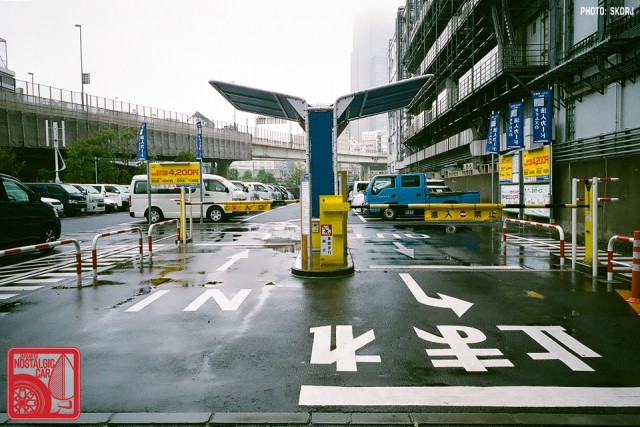
2. The Boom-Gate Coin Park
The rising-steel-bar coin parks, as described in Part 01, are generally no larger than 20 or so spaces. It’s common though, to see Tokyo lots with only two spaces. Somewhere in Japan, I’m certain there’s a steel-bar coin park for just one spot. For larger lots, there’s the boom gate coin park.
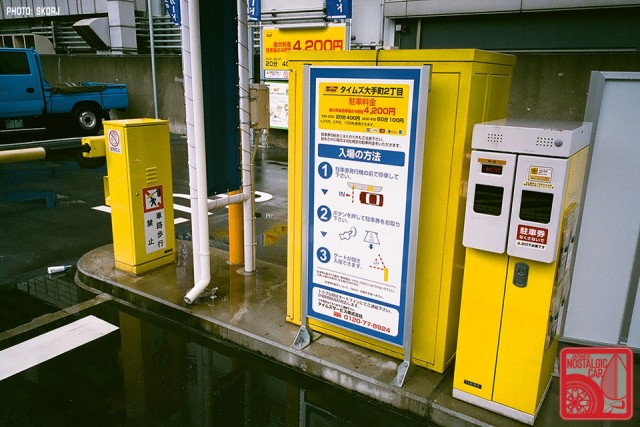
Boom-gate coin parks are perhaps familiar to those outside Japan too, and operate just as they do anywhere else. You take your ticket on entry, park your car, and go about your business. When it’s time to leave, you get back in your car, drive up to the gate, which is blocked by a boom, put your ticket in the machine, wait with excitement as it calculates your fee, and after depositing coins and cash, the boom-gate raises and you are free.
While simple in theory, this is what the machine actually looks like. See how it is clearly labeled and easy to understand, especially for foreigners?
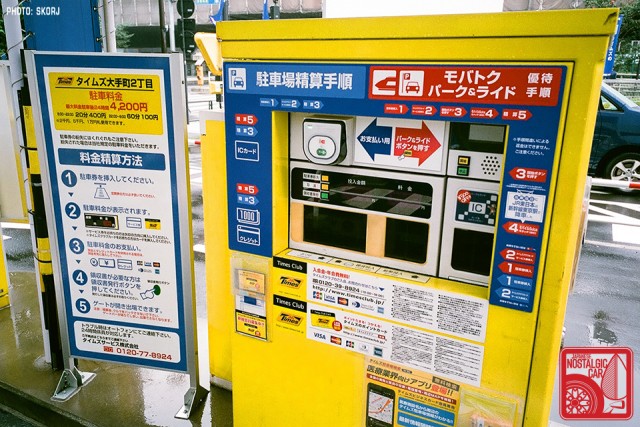
Actually, this machine near Tokyo station provides an additional option called Paku-&-Raido (Park & Ride). Sold in conjunction with a Shinkansen ticket, the parking portion of the fee is less than a car-only fee. This really simple exit machine is perhaps more typical. Note both machines allow Suica, Pasmo, and other O-Saifu (digital wallet) payments via either card orkeitai (mobile telephone) billing.
This, however, is where the simple difference between bar- and boom-style parks becomes apparent. Forward thinkers would have already recognized the bar-style coin park does not issue a ticket, eliminating the question, “What do I do if I lose my ticket?”

So, what do you do, with no attendant, when you lose your ticket? Simple! We have a button for that! Highlighted in red above, loosely translated it says, “Push this button if you want to see just how much money we think you will pay to get your car out.”
If you thought the excitement of calculating the normal day or night rate was fun, just wait until you arrive at the exit machine, find a queue of cars behind you, and cannot find your ticket. The accepted fee for losing your ticket is perhaps a few days’ worth of the maximum day rate. So, you can be expected to pay between 5000 to perhaps 30,000円 ($40 – $250) depending on how careless you’ve been.

Some of the newer machines now take credit cards, but otherwise you’ll need the cash. If you’re an Aston Martin-driving investment banker, coughing up the value of a round of drinks at Legato in Shibuya is nothing. But, if you’re an English instructor from Kanagawa-ken, this can be one year’s salary. There is of course nothing you can do about it, except perhaps write a snarky article for internet readers.


As an aside, I once parked in a boom park in Roppongi — in the notoriously tsukebe and dangerous “High Touch Town” in Tokyo — and the fee for a few hours was over 5000円. Not having the right cash (the machines generally only take 1000円 notes), I paid with my credit card. The next day, my bank telephoned me as the payment had been red-flagged with an automatic stop and the operator wanted to know if I’d accept a charge billed from a “known organized crime syndicate.” Not wanting to make new friends knocking on my door at midnight looking for their money, I of course authorized.

3. Stacking
Depending on your outlook on life in general, the parking elevator, parking turn-table, parking stacker, and multi-level external access ramps combine for either maximum stress, or maximum fun.

In some multi-level car garages you drive up and down yourself. To gain access to each floor, many of these have been constructed with an over-sized spiral Hot Wheels track tacked onto the outside of the building, and if you think that sounds exciting, you would be correct.
Barely wide enough for one car, full steering lock is generally required, and constant braking is required when going down to stop from nerfing the outer barrier with a multi-level nose dive to the pavement below. A few times a year, someone takes the Hot Wheels scenario a little too far. Also, a few of these did not survive the Tohoku Earthquake. Many people avoid them accordingly.
That is why most places employ the automated stacking method. One popular option is an elevator-style parking tower. A platform rises through the middle column and retrieves cars using the slabs of steel they are parked on from either the left or right. On more advanced ones, there is enough space to turn the car 90 degrees so it’s facing the right way when you want to drive out.


Often looking like conventional office buildings, the stacking parking garages are either controlled by a regular boom-gate at the bottom, a ticket machine, or in some cases an attendant. Private constructions of a similar nature generally use a single key to gain access to your car, delivering it to ground level for driving away.
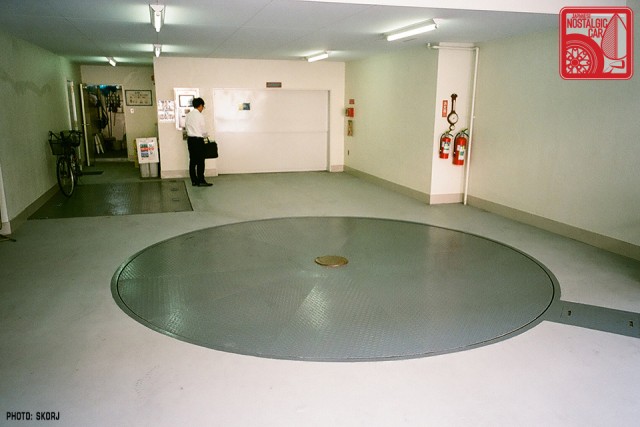
Turntables are provided to allow drive-in and drive-out access with no need to engage in risky reserving behavior. Sometimes multiple stackers — like a Ferris wheel for your car — are provided in parallel in the one facility.
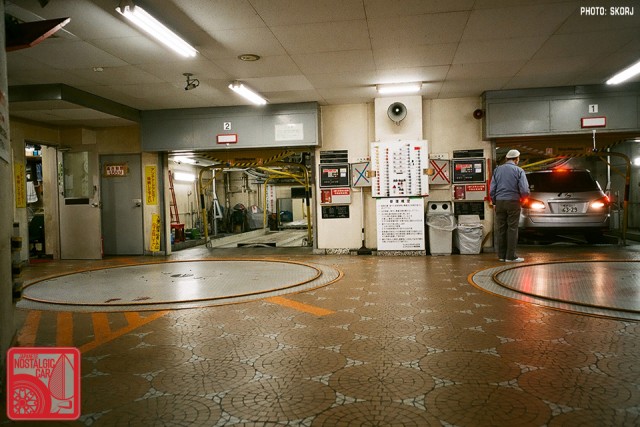
A series of mirrors, lights, and buzzers helps you align your car as you drive into the stacker, similar perhaps to a drive-through car wash. Once in position, the car then disappears behind closed doors, out of sight like some sort of time and space transporter. Magically appearing the right way around to drive out again on command.
Here’s what happens when your car goes off on its little adventure.
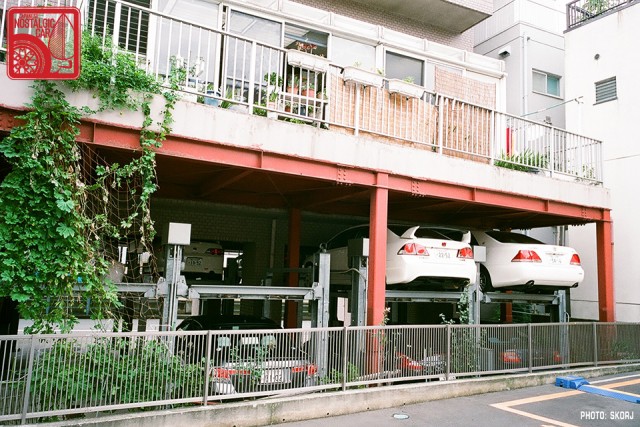
In cramped cities, even residential spots are often stacked. You don’t even need to know the neighbor parking below you. The upper level is often hinged to set the car down in front of the car below, allowing you to drive off without moving the car on the ground level. As you can see, this is why oil leaks are a necessary part of the Shaken inspection. As a bonus result, though, Japanese roads are spot-free.
La semana que viene la tercera parte, estad atentos. Fuente: JNC

